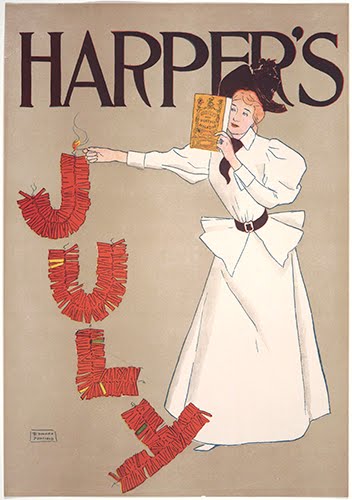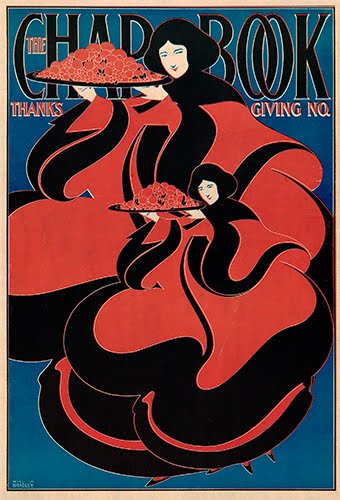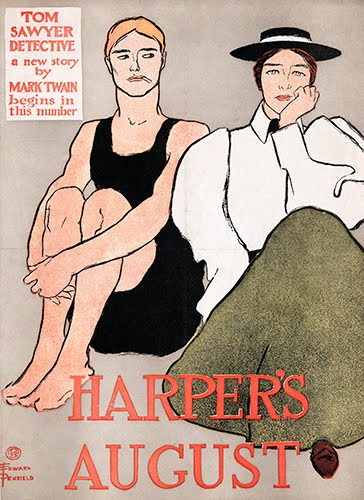Happy July 2018: Edward Penfield
I want to wish everyone a happy July, even though it pains me when I think that the summer is half over, here in New England anyway. However, what better way to ignore that idea than to focus on art?
While many art historians date the American poster “renaissance” to 1890–1900, I am more liberal and find lots of exciting examples well into the 1930s. A narrow classification, I feel, limits it to French poster pioneer Henri de Toulouse-Lautrec's (1864–1901) period of productivity, and I think American graphic artists did equally exciting things in the genre.
 |
| Edward Penfield (1866–1925, United States), Harper’s July, poster for Harper’s New Monthly Magazine, July 1894. Zinc etching on paper, 18 1/8" x 12 9/16" (46 x 32 cm). © 2018 Museum of Fine Arts, Boston. (MFAB-215) |
Edward Penfield (1866–1925) is often mentioned as one of the most important poster artists of the period and his work is distinctly American in outlook. Along with his fellow “star” of poster art, Will Bradley (1868–1962), Penfield helped establish a “look” that was influenced by Art Nouveau aesthetics, but also reflect the major changes taking place in American society, particularly a world in which increasing numbers of women were finding jobs outside the home. The poster art of these two artists sought to define the “typical American girl,” which still was not much of a liberated idea, since women could not vote at the time.
Penfield was born in Brooklyn and grew up with a single mother. He decided to become an illustrator, influenced by his uncle Henry Lewis Penfield (1825–1901), who was an engraver in New York supplying work for publishers. He enrolled in the Art Students’ League in New York and studied painting under George de Forest Brush (1854/1855–1941), an artist known for painting the American West and developing military camouflage. Around 1890, Penfield was offered a job as a staff illustrator of Harper’s Weekly magazine, based on works he had exhibited. Early duties included cleaning up and inking other artist’s sketches and making small illustrations from photographs. His first published work appeared in Harper’s Weekly in 1891. A visit to Paris in 1892 exposed Penfield to the Art Nouveau craze. When he returned to the US he became the head of the art department at Harper’s until he retired in 1901.
Penfield’s illustrations were meant to appeal to the stylish men and women of the burgeoning middle class. There is an influence of Art Nouveau and Japanese ukiyo-e prints in the flat shapes, asymmetrical compositions, and emphasis on swirling contour lines. His contour lines are less animated, however, than those of Bradley.
 |
| William Bradley (1868–1962 US), Poster for Thanksgiving No. of Chap Book, 1895. Zincograph on paper, 20 ¾" x 14" (52.7 x 35.6 cm). The Museum of Modern Art, New York. © 2018 artist or artist’s estate. (MOMA-P0003) |
Below is a Penfield for August, just to keep you going. I love the onesie swimming suit on the dude, but not that pathetic excuse for a cigarette in his mouth. Of course, the man is allowed to flaunt sexuality in the bathing suit, while the woman is depicted prim and proper. Maybe the whole scenario is why Penfield depicted her looking a little frustrated, especially since it was frowned upon at the time for women to smoke? Probably not.
 |
| Edward Penfield (1866–1925, US), Harper’s August, poster for Harper’s New Monthly Magazine, August, 1896. Zinc etching on paper, 18 9/16" x 13 7/16" (47.2 x 34.2 cm). © 2018 The Museum of Modern Art, New York. (MOMA-D0573) |
Correlations to Davis programs: A Personal Journey: 4.3; Explorations in Art Grade 3: 3.7; Explorations in Art 2E Grade 3: 3.7; Explorations in Art Grade 6: 5.27; Explorations in Art 2E Grade 6: 5.6; Communicating through Graphic Design: 3, 6


Comments